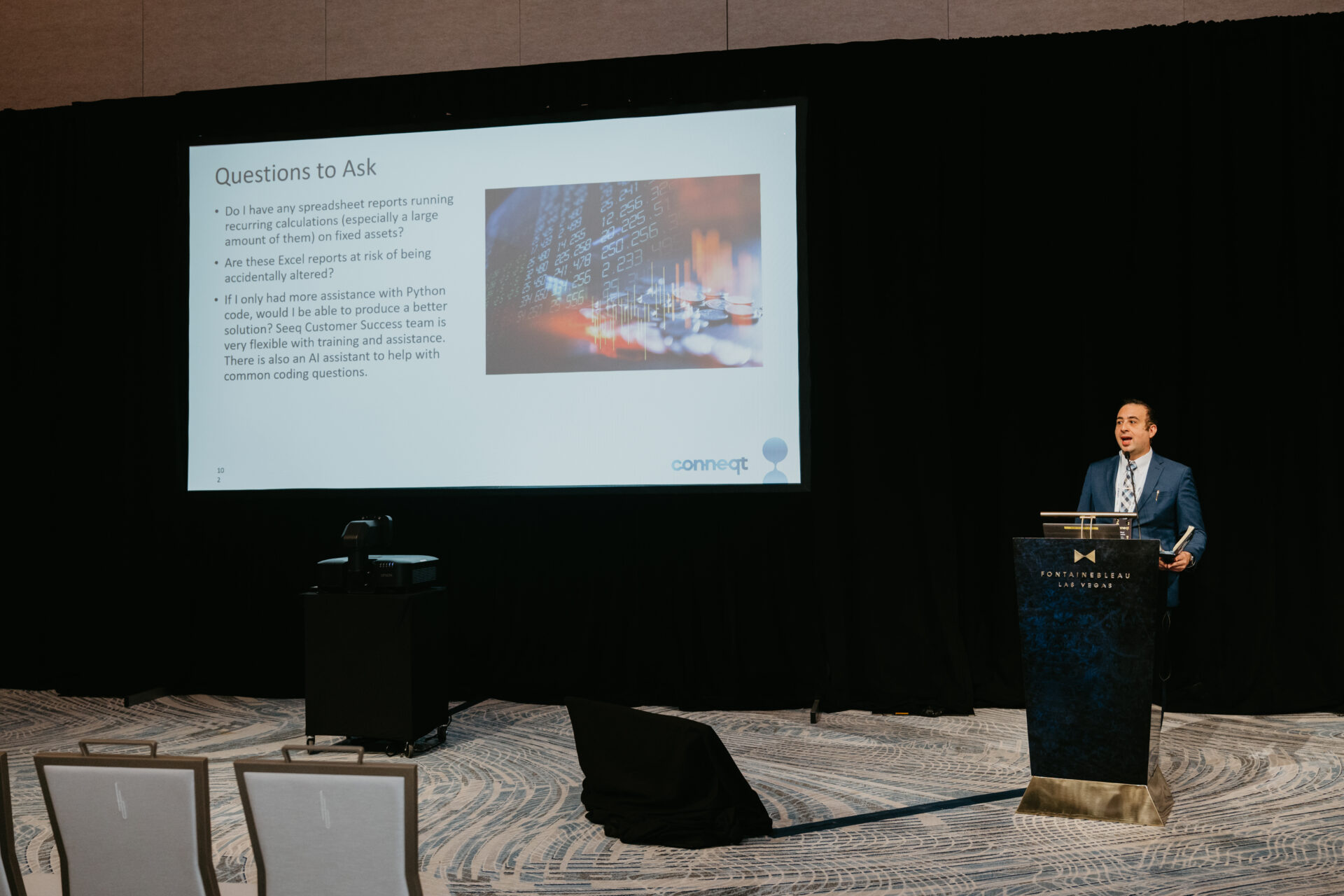
Driving Operational Excellence with Advanced Analytics in Oil & Gas
The Oil & Gas Track at Conneqt 2025 brought together industry leaders and innovators to explore the evolving landscape of oil and gas, offering a focused lens on the challenges and opportunities shaping the sector today. With sessions on digital transformation, operational efficiency, workforce empowerment, and more, the track highlighted how industrial analytics, AI, and enterprise monitoring are driving meaningful change to address the industry’s toughest challenges.
In this recap, we’ll highlight the key takeaways that stood out from this track.

Phillips 66: Precision Coke Drum Blowout Identification
At Phillips 66, ERI engineers Ryan DeFever, Cliff Amundsen, and consulting process engineer Sjoerd Hoogwater demonstrated how the company employed Seeq to detect and analyze coke drum blowouts, a significant safety concern in refinery operations.
Previously, traditional methods overlooked smaller events due to cumbersome analysis processes. With Seeq Data Lab, the company can quickly identify these minor blowouts, providing greater clarity on incident patterns and occurrences and guiding more effective mitigation strategies. This implementation drastically reduces manual analysis time, turning weeks of manual data processing into hours of analysis, enabling faster operational improvements and enhancing overall safety.
Key Takeaways:
- Analytics-driven solutions transform safety monitoring, enhancing operational reliability.
- Rapid data processing reveals event clusters previously unidentified through manual analysis.
- Scalable analytics solutions allow for proactive mitigation strategies, significantly improving refinery safety.
Marathon Pipe Line: Streamlining Pressure Cycle Analytics
Kyle Miller, Innovation Manager at Marathon Pipe Line, shared how Marathon Pipe Line leveraged Seeq Data Lab to automate the process of pressure cycle counting, a critical step for predicting pipeline fatigue and ensuring operational integrity. As a result, the company saw a significant reduction in analysis time–from multiple days to mere minutes.
This approach eliminates dependency on third-party tools, improving data reliability and saving approximately $50,000 annually. By quickly assessing cumulative pipeline damage, they enhance safety and operational efficiency.
Key Takeaways:
- Automation in analytics reduces analysis time from weeks to minutes, significantly reducing operational costs.
- Improved accuracy in cumulative damage assessment ensures regulatory compliance and asset safety.
- Analytics integration provides substantial financial savings and enhanced asset reliability.
Major Energy Producer: Enhancing Deepwater Production Stability with Advanced Analytics
A leading global energy company discussed managing complex challenges in deepwater oil production, particularly instability caused by fluid dynamics in production risers. Traditional modeling methods lacked the speed and accuracy required for real-time decision-making, negatively impacting operational stability and data reliability.
Strategically, the company implemented advanced analytics to enhance operational responsiveness and decision-making. Technically, they deployed statistical models integrated into business intelligence tools for improved real-time monitoring.
Key Takeaways:
- Advanced analytics provide actionable real-time insights, significantly improving operational stability.
- Enhanced predictive capabilities through experiential data maps reduce downtime and ensure process continuity.
- Integration with visualization tools drives faster, informed decision-making across teams.
Energy Transfer: Enhancing Midstream Operations with Advanced Analytics
Energy Transfer’s Trey Morris, Principal Specialist for Operational Data Analytics, joined Seeq’s Patrick Weber, Principal Analytics Engineer, to discuss how Energy Transfer implemented Seeq Vantage to significantly improve predictive maintenance and proactive asset management capabilities across their extensive pipeline network.
The company replaced reactive monitoring with a flexible, condition-agnostic system that supports real-time operational alerts, machine learning predictions, and anomaly detection. Seeq’s centralized “Vantage Room” improved cross-functional collaboration and provided a unified, reliable source of actionable insights. This solution delivered notable reductions in asset downtime and maintenance costs, increased operational efficiency, and fostered scalable growth to meet evolving operational complexity
Key Takeaways:
- Analytics-driven predictive maintenance reduces asset downtime and operational disruptions.
- Real-time monitoring and anomaly detection improve asset reliability and throughput efficiency.
- Enhanced operational risk management through integrated analytics ensures regulatory compliance and improved safety outcomes.

Tallgrass Energy: Optimizing Turbine Overhaul Scheduling
John Spelic, Manager of Automation & Equipment Analysis at Tallgrass Energy, demonstrated how Tallgrass used Seeq to achieve significant optimization in turbine overhaul scheduling across multiple compressor stations, addressing the challenge of managing unpredictable runtimes and fluctuating pipeline conditions.
The integration of Seeq provides real-time visualization of turbine operating hours and status, simplifying monitoring and enabling rapid response to undesirable configurations. Automating the scheduling process has already delivered substantial financial benefits, saving approximately $6 million immediately, with projected additional savings of up to $12 million. This strategic capability ensures predictable maintenance costs, stable financial planning, and enhanced long-term operational reliability.
Key Takeaways:
- Analytics-driven overhaul scheduling dramatically reduces maintenance costs and enhances financial predictability.
- Real-time operational visibility improves reaction times to undesirable configurations, optimizing asset usage.
- Substantial savings of approximately $12M over three years illustrate analytics’ strategic value in operational planning.
Western Midstream: Revolutionizing Regulatory Reporting for SWD Wells
Albert Swalha from Western Midstream presented how Seeq streamlined regulatory reporting for saltwater disposal (SWD) wells required by the Railroad Commission of Texas. Prior reporting methods were cumbersome, error-prone, and time-consuming, taking nearly 24 hours to complete each month. Using Seeq’s combined applications—Workbench, Data Lab, and Organizer—they automated data cleansing, analysis, and report generation, reducing monthly effort to only 1-2 hours.
Key Takeaways:
- Dramatic reduction in administrative burden—reporting time cut by over 90%, freeing resources for critical tasks.
- Automated exception reporting proactively identifies and addresses compliance issues.
- Scalability of analytics solutions ensures efficient integration of new assets.

Common Threads: Operational Excellence, Collaboration, and Scalable Insights
Across all presentations, a consistent theme emerged: leveraging advanced analytics platforms like Seeq empowers organizations to bridge operational gaps, foster cross-functional collaboration, and generate scalable insights. Tangible outcomes include increased operational stability, enhanced safety measures, streamlined regulatory compliance, and significant financial benefits.
By going All In on analytics-driven operational excellence, the oil & gas industry isn’t just optimizing processes—they’re unlocking new opportunities for innovation and sustained growth.
We thank all presenters for sharing their transformative journeys at Conneqt 2025 and look forward to continued collaboration in leveraging data-driven insights.
To explore more Conneqt 2025 sessions, visit our Video Hub.